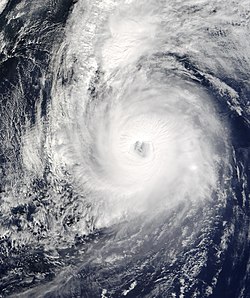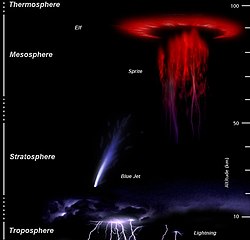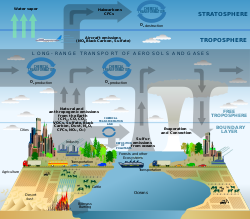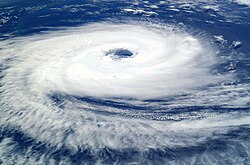Dominant group/Atmospheric sciences

Atmospheric sciences is an umbrella term for the study of the Earth's and other astronomical objects' atmospheres, its processes, the effects other systems have on the atmosphere, and the effects of the atmosphere on these other systems.
Any dominant group in the atmospheric sciences is expected to be either an entity, source, or object of these sciences or a group in some way associated with these sciences.
Notations
[edit | edit source]Notation: let the symbol VOC indicate Volatile Organic Compounds.
Sciences
[edit | edit source]Def. the disciplines or branches of learning, especially those "dealing with measurable or systematic principles ... the collective [disciplines] of study or learning acquired through the scientific method"[1] are called the sciences.
Def. in the definite "[a] method of discovering knowledge about the natural world based in making falsifiable predictions (hypotheses), testing them empirically, & developing theories that match known data from repeatable physical experimentation"[2] is called the scientific method.
Def. "[b]eing in a position of power, authority or ascendancy over others"[3] is called dominance, or "[t]he state of being dominant; of prime importance".[3]
Dominant group
[edit | edit source]Examples from primary sources are to be used to prove or disprove each hypothesis. These can be collected per subject or in general.
- Accident hypothesis: dominant group is an accident of whatever processes are operating.
- Artifact hypothesis: dominant group may be an artifact of human endeavor or may have preceded humanity.
- Association hypothesis: dominant group is associated in some way with the original research.
- Bad group hypothesis: dominant group is the group that engages in discrimination, abuse, punishment, and additional criminal activity against other groups. It often has an unfair advantage and uses it to express monopolistic practices.
- Control group hypothesis: there is a control group that can be used to study dominant group.
- Entity hypothesis: dominant group is an entity within each field where a primary author of original research uses the term.
- Evolution hypothesis: dominant group is a product of evolutionary processes, such groups are the evolutionary process, produce evolutionary processes, or are independent of evolutionary processes.
- Identifier hypothesis: dominant group is an identifier used by primary source authors of original research to identify an observation in the process of analysis.
- Importance hypothesis: dominant group signifies original research results that usually need to be explained by theory and interpretation of experiments.
- Indicator hypothesis: dominant group may be an indicator of something as yet not understood by the primary author of original research.
- Influence hypothesis: dominant group is included in a primary source article containing original research to indicate influence or an influential phenomenon.
- Interest hypothesis: dominant group is a theoretical entity used by scholarly authors of primary sources for phenomena of interest.
- Metadefinition hypothesis: all uses of dominant group by all primary source authors of original research are included in the metadefinition for dominant group.
- Null hypothesis: there is no significant or special meaning of dominant group in any sentence or figure caption in any refereed journal article.
- Object hypothesis: dominant group is an object within each field where a primary author of original research uses the term.
- Obvious hypothesis: the only meaning of dominant group is the one found in Mosby's Medical Dictionary.
- Original research hypothesis: dominant group is included in a primary source article by the author to indicate that the article contains original research.
- Primordial hypothesis: dominant group is a primordial concept inherent to humans such that every language or other form of communication no matter how old or whether extinct, on the verge of extinction, or not, has at least a synonym for dominant group.
- Purpose hypothesis: dominant group is written into articles by authors for a purpose.
- Regional hypothesis: dominant group, when it occurs, is only a manifestation of the limitations within a region. Variation of those limitations may result in the loss of a dominant group with the eventual appearance of a new one or none at all.
- Source hypothesis: dominant group is a source within each field where a primary author of original research uses the term.
- Term hypothesis: dominant group is a significant term that may require a 'rigorous definition' or application and verification of an empirical definition.
A humanistic approach to a dominant group in the atmospheric sciences likely involves individualization of the dominant group members so as to treat each member as an individual. The result of such individualist effort is the dissolution of the dominant group. The key is to show that the collective criteria of dominance that composes the group is only manifested individually rather than through conspiracy.
Each individual entity that has a position of power, authority or ascendancy over other entities is viewed without any more power, authority or ascendancy than any entity. In short, the hierarchy is dissolved and manifestations are viewed only as part of a spectrum of differences.
Atmospheres
[edit | edit source]Def. "[t]he gases surrounding the Earth or any astronomical body"[4] are called an atmosphere.
Def. the invisible gaseous substance "above the surface of the earth"[5] is called air.
Def. "[t]he air in a particular place"[4] is called an atmosphere.
Aerology
[edit | edit source]Def. "[t]he observation of the atmosphere"[6] is called aerology.
"From these data there is no longer any doubt that dominant group microseisms are generated by various types of meteorological disturbances over the oceans."[7]
Aeronomy
[edit | edit source]
Def. "the atmosphere of the Earth and the other planets with reference to their chemical composition, physical properties, relative motion, and responses to radiation from space"[8] is called aeronomy.
Aeronomy is the study of the upper layers of the atmosphere, where dissociation and ionization are important.
Aeronomy is the science of the upper region of the atmosphere, where dissociation and ionization are important.[9]
Compounds
[edit | edit source]
“Aromatic VOCs is the dominant group both for new and in-use 4-stroke engines. Alkane VOCs is the dominant group for 2-stroke engines.”[10]
“2-Decenal and 2-undecanal were the main components in this class of aldehydes and alkenals were the dominant group in all three cooking oils at both temperatures studied, except in canola oil at 180 °C.”[11]
“Additionally, both species fall into the 10 same functional group (ie reactive aromatics) (Zhang et al., 2004), and thus their ratio will be most relevant to this most dominant group.”[12]
Meteors
[edit | edit source]“These values yield a dominant group velocity consistent with the Eady lee wave extension along the y axis in Fig. 5f:
- Cg ≈ (6,-20) m s-1”[13]
“Silicate particle types of probable crustal origin were the dominant group by volume through most of the period.”[14]
“The 73 “silicate group” PM 2.5 analyses from the Lizard mostly comprise felsic particles (84%), with the Al-felsic (52%) being by far the most dominant group, followed by AlSi-felsic (20%) and relatively little quartz-rich material (Fig. 10).”[15]
“In contrast, on weekends, gasoline vehicles were the dominant group, except at midnight.”[16]
“When gasoline and LPG vehicles were the dominant types of running vehicles, OC/EC ratios were larger than 1.0.”[16]
“Gasoline- and LPG-vehicle exhaust had similar carbon profiles; i.e., OC3 was the dominant species, followed by OC2.”[16]
“Days with liquid precipitation (rain and drizzle) are a dominant group and account for 58.1% of all precipitation days.”[17]
Atmochemistry
[edit | edit source]
"The biogenic volatile organic compounds (BVOC) include the quantitatively dominant group of the isoprenoids [isoprene, monoterpenes (e.g. α-pinene), sesquiterpenes] and oxygen-containing species (OVOC), such as alcohols, carbonyls and organic acids."[18]
"Group 1 was the dominant group and accounted for 45.00%, 33.04%, 48.36% of the total trajectories in 2004–2005, 2006–2007, and 2007–2008, respectively."[19]
Tropospheric ozone: “The dominant groups were chosen from the dendrogram based on three criteria: (1) minimize the scatter around the mean curve for each dominant group; (2) the number of classification days within each group had to approach or exceed the number of variables in the subsequent discriminant analysis (24 in our case), and (3) retain the smallest number of groups satisfying criteria (1) and (2).”[20]
Atmophysics
[edit | edit source]"There is a dominant group of periodicities around 4±7 years, which may be associated with the ENSO phenomena."[21]
"It is the speed of the dominant group that remains because of the self-canceling rapid oscillations away from the point of stationary phase."[22]
Climatology
[edit | edit source]
Climatology "is the study of climate, scientifically defined as weather conditions averaged over a period of time,[23] and is a branch of the atmospheric sciences."[24]
Climate encompasses the statistics of temperature, humidity, atmospheric pressure, wind, rainfall, atmospheric particle count and numerous other meteorological elements in a given region over long periods of time.
"From the outset WG1, chaired by Sir John Houghton of the UK Meteorological Office, was the dominant group."[25]
"A dominant group size of at least 50% might be a useful criterion since a size smaller than 50% would mean that the other two groups combined would outnumber the dominant group. Ten of the 20 circulation types shown in Fig. 3 pass this test."[26]
"Relevant amongst our findings is that sinuous tracks are the minority group from May to August, but then become the dominant group from September through to December, suggesting a major shift in the degree of synoptic control on typhoon movement between the first and second half of the typhoon season"[27]
"The results of the factor analysis show that the rainfall characteristics (amount, intensity, duration) are the dominant group of factors, representing the highest weight for explaining the amount of throughfall, with high positive correlations (r = 0.99; r = 0.90 yr = 0.83, respectively)."[28]
Meteorology
[edit | edit source]
Def. "[t]he study of the atmosphere and its phenomena, especially with weather and weather forecasting"[29] is called meteorology.
“The dashed lines mark a distance of 500 m, and the arrow gives the travel direction of the dominant group in the images.”[30]
Weather astronomy
[edit | edit source]"A dominant group size of at least 50% might be a useful criterion since a size smaller than 50% would mean that the other two groups combined would outnumber the dominant group."[26]
Weather forecasting astronomy
[edit | edit source]"In the currently proposed method, that is, if no information about the land use distribution for a grid cell is available, we shall use only the A type station as it belongs to the dominant group."[31]
Hypotheses
[edit | edit source]- A dominant group in the atmospheric sciences may prevent acceptance of the effects the natural electric field of the Earth has on the Earth's atmosphere.
See also
[edit | edit source]References
[edit | edit source]- ↑ "science". San Francisco, California: Wikimedia Foundation, Inc. February 15, 2013. Retrieved 2013-02-19.
- ↑ "scientific method". San Francisco, California: Wikimedia Foundation, Inc. December 27, 2012. Retrieved 2013-02-19.
- ↑ 3.0 3.1 "dominance". San Francisco, California: Wikimedia Foundation, Inc. February 9, 2013. Retrieved 2013-02-19.
- ↑ 4.0 4.1 212.159.113.112 (6 May 2003). atmosphere. San Francisco, California: Wikimedia Foundation, Inc. https://en.wiktionary.org/wiki/atmosphere. Retrieved 2016-02-06.
- ↑ "air". San Francisco, California: Wikimedia Foundation, Inc. February 10, 2013. Retrieved 2013-02-22.
- ↑ "aerology". San Francisco, California: Wikimedia Foundation, Inc. October 16, 2012. Retrieved 2013-02-22.
- ↑ Marion H. Gilmore (December 1953). James T. Wilson, Frank Press. ed. Amplitude distribution of storm microseisms, In: Symposium on Microseisms'. Washington, DC: National Academy of Sciences, National Research Council. pp. 20-55. http://books.google.com/books?id=-UIrAAAAYAAJ&printsec=frontcover&hl=en. Retrieved 2012-02-22.
- ↑ "aeronomy". San Francisco, California: Wikimedia Foundation, Inc. March 26, 2012. Retrieved 2013-02-22.
- ↑ Sydney Chapman (1960). The Thermosphere - the Earth's Outermost Atmosphere. Physics of the Upper Atmosphere. Academic Press. pp. 4. ISBN 978-0125820509.
- ↑ Jiun-Horng Tsai; Yih-Chyun Hsu; Hung-Cheng Weng; Wen-Yinn Lin; Fu-Tien Jeng (2000). "Air pollutant emission factors from new and in-use motorcycles". Atmospheric Environment 34 (28): 4747-54. doi:10.1016/S1352-2310(00)00270-3. http://ntur.lib.ntu.edu.tw/bitstream/246246/96720/1/04.pdf. Retrieved 2012-02-21.
- ↑ Andres Fullana; Ángel A Carbonell-Barrachina; Sukh Sidhu (December 2004). "Volatile aldehyde emissions from heated cooking oils". Journal of the Science of Food and Agriculture 84 (15): 2015-21. doi:10.1002/jsfa.1904. http://onlinelibrary.wiley.com/doi/10.1002/jsfa.1904/full. Retrieved 2012-02-21.
- ↑ J. Zhang; T. Wang; W. L. Chameides; C. Cardelino; D. R. Blake; D. G. Streets (May 2008). "Source characteristics of volatile organic compounds during high ozone episodes in Hong Kong, Southern China". Atmospheric Chemistry and Physics Discussions 8 (3): 8847-79. http://hal.archives-ouvertes.fr/docs/00/30/41/61/PDF/acpd-8-8847-2008.pdf. Retrieved 2012-02-21.
- ↑ Armel Martin; François Lott (March 2007). "Synoptic Responses to Mountain Gravity Waves Encountering Directional Critical Levels". Journal of the Atmospheric Sciences 64 (3): 828-48. doi:10.1175/JAS3873.1. http://journals.ametsoc.org/doi/full/10.1175/JAS3873.1. Retrieved 2011-10-21.
- ↑ James R. Anderson; Peter R. Buseck; Daniel A. Saucy (June 1992). "Characterization of individual fine-fraction particles from the Arctic aerosol at Spitsbergen, May-June 1987". Atmospheric Environment. Part A. General Topics 26 (9): 1747-62. doi:10.1016/0960-1686(92)90072-S. http://www.sciencedirect.com/science/article/pii/096016869290072S. Retrieved 2012-02-21.
- ↑ Teresa Moreno; Wes Gibbons; Tim Jones; Roy Richards (September 2003). "The geology of ambient aerosols: characterising urban and rural/coastal silicate PM10-2.5 and PM2.5 using high-volume cascade collection and scanning electron microscopy". Atmospheric Environment 37 (30): 4265-76. doi:10.1016/S1352-2310(03)00534-X. http://www.sciencedirect.com/science/article/pii/S135223100300534X. Retrieved 2012-02-21.
- ↑ 16.0 16.1 16.2 J.J. Cao; S.C. Lee; K.F. Ho; Kochy Fung; Judith C. Chow; John G. Watson (June 2006). "Characterization of roadside fine particulate carbon and its eight fractions in Hong Kong". Aerosol and Air Quality research 6 (2): 106-22. http://aaqr.org/VOL6_No2_June2006/1_AAQR-06-06-OA-0001_106-122.pdf. Retrieved 2012-02-21.
- ↑ Robert Twardosz; Tadeusz Niedźwiedź; Ewa Łupikasza (May 2011). "The influence of atmospheric circulation on the type of precipitation (Kraków, southern Poland)". Theoretical and Applied Climatology 104 (1-2): 233-50. doi:10.1007/s00704-010-0340-5. http://www.springerlink.com/index/A2834828713K0415.pdf. Retrieved 2012-02-21.
- ↑ R. Steinbrecher; B. Rappenglück; A. Hansel; M. Graus; O. Klemm; A. Held; A. Wiedensohler; A. Nowak (2004). Egbert Matzner. ed. The Emissions of Biogenic Volatile Organic Compounds (BVOC) and Their Relevance to Atmospheric Particle Dynamics, In: Biogeochemistry of Forested Catchments in a Changing Environment A German Case Study. Berlin: Springer-Verlag. pp. 215-32. ISBN 3-540-20973-5. http://books.google.com/books?id=9AWCt2ULM4QC&printsec=frontcover&dq=Biogeochemistry+of+forested+catchments+in+a+changing+environment:&hl=en. Retrieved 2012-02-22.
- ↑ Shuhui Cheng; LingXiao Yang; Xuehua Zhou; Zhe Wang; Yang Zhou; Xiaomei Gao; Wei Nie; Xinfeng Wang et al. (2011). "Evaluating PM2. 5 ionic components and source apportionment in Jinan, China from 2004 to 2008 using trajectory statistical methods". Journal of Environmental Monitoring 13 (6): 1662-71. doi:10.1039/C0EM00756K. http://xlink.rsc.org/?doi=c0em00756k. Retrieved 2012-02-22.
- ↑ M. Böhm; B. McCune; T. Vandetta (1991). "Diurnal curves of tropospheric ozone in the western United States". Atmospheric Environment. Part A. General Topics 25 (8): 1577-90. doi:10.1016/0960-1686(91)90016-Z. http://www.sciencedirect.com/science/article/pii/096016869190016Z. Retrieved 2011-10-21.
- ↑ M. Indeje; F. H. M. Semazzi (May 2000). "Relationships Between QBO in the Lower Equatorial Stratospheric Zonal Winds and East African Seasonal Rainfall". Meteorology and Atmospheric Physics 73 (3-4): 227-44. doi:10.1007/s007030050075. http://www.springerlink.com/index/5VJTTN5CUBWQ94FK.pdf. Retrieved 2012-05-22.
- ↑ John H. E. Clark (March 1999). "Gravity Waves Driven by Diurnal Fluctuations in Mesoscale Heating". Journal of the Atmospheric Sciences 56 (5): 769-83. doi:10.1175/1520-0469(1999)056<0769:GWDBDF>2.0.CO;2. http://journals.ametsoc.org/doi/abs/10.1175/1520-0469(1999)056%3C0769%3AGWDBDF%3E2.0.CO%3B2. Retrieved 2013-02-22.
- ↑ "Climate Prediction Center Climate Glossary". Retrieved November 23, 2006.
- ↑ "Climatology". San Francisco, California: Wikimedia Foundation, Inc. May 17, 2012. Retrieved 2012-05-22.
- ↑ John Lanchbery; David Victor (1995). Helge Ole Bergesen, Georg Parmann, and Øystein B. Thommessen. ed. The role of Science in the Global Climate Negotiations, In: Green Globe Yearbook of International Co-operation on Environment and Development. Oxford: Oxford University Press. pp. 29–39. http://www.fni.no/YBICED/95_02_lanchbery.pdf. Retrieved 2012-02-04.
- ↑ 26.0 26.1 W. A. R. Brinkmann (June 1999). "Application of non-hierarchically clustered circulation components to surface weather conditions: Lake Superior Basin winter temperatures". Theoretical and Applied Climatology 63 (1-2): 41-56. doi:10.1007/s007040050090. http://www.springerlink.com/index/23XY6LRYUU4W7JK2.pdf. Retrieved 2012-02-04.
- ↑ James P. Terry; Chen-Chieh Feng (December 2010). "On quantifying the sinuosity of typhoon tracks in the western North Pacific basin". Applied Geography 30 (4): 678-86. doi:10.1016/j.apgeog.2010.01.007. http://www.sciencedirect.com/science/article/pii/S0143622810000172. Retrieved 2012-02-04.
- ↑ Beatriz Mateos; Susana Schnabel (2001). "Rainfall interception in Mediterranean open woodland". Cuadernos de Investigación Geográfica (27): 27-38. http://dialnet.unirioja.es/servlet/dcfichero_articulo?codigo=258448&orden=74436. Retrieved 2012-02-04.
- ↑ "meteorology". San Francisco, California: Wikimedia Foundation, Inc. February 16, 2013. Retrieved 2013-02-21.
- ↑ Dankert, H.; Horstmann, J.; Lehner, S.; Rosenthal, W. (June 2003). "Detection of wave groups in SAR images and radar image sequences". IEEE Transactions on Geoscience and Remote Sensing 41 (6): 1437-46. doi:10.1109/TGRS.2003.811815. http://ieeexplore.ieee.org/xpl/freeabs_all.jsp?arnumber=1220252. Retrieved 2011-10-21.
- ↑ Yulia R. Gel (December 2007). "Comparative Analysis of the Local Observation-Based (LOB) Method and the Nonparametric Regression-Based Method for Gridded Bias Correction in Mesoscale Weather Forecasting". Weather and Forecasting 22: 1243-56. doi:10.1175/2007WAF2006046.1. http://journals.ametsoc.org/doi/pdf/10.1175/2007WAF2006046.1. Retrieved 2012-05-22.
Further reading
[edit | edit source]- Robert Twardosz; Tadeusz Niedźwiedź; Ewa Łupikasza (May 2011). "The influence of atmospheric circulation on the type of precipitation (Kraków, southern Poland)". Theoretical and Applied Climatology 104 (1-2): 233-50. doi:10.1007/s00704-010-0340-5. http://www.springerlink.com/index/A2834828713K0415.pdf. Retrieved 2012-02-21.
- J. Zhang; T. Wang; W. L. Chameides; C. Cardelino; D. R. Blake; D. G. Streets (May 2008). "Source characteristics of volatile organic compounds during high ozone episodes in Hong Kong, Southern China". Atmospheric Chemistry and Physics Discussions 8 (3): 8847-79. http://hal.archives-ouvertes.fr/docs/00/30/41/61/PDF/acpd-8-8847-2008.pdf. Retrieved 2012-02-21.
External links
[edit | edit source]- African Journals Online
- Bing Advanced search
- Google Books
- Google scholar Advanced Scholar Search
- International Astronomical Union
- JSTOR
- Lycos search
- NASA/IPAC Extragalactic Database - NED
- NASA's National Space Science Data Center
- NCBI All Databases Search
- Office of Scientific & Technical Information
- PsycNET
- PubChem Public Chemical Database
- Questia - The Online Library of Books and Journals
- SAGE journals online
- The SAO/NASA Astrophysics Data System
- Scirus for scientific information only advanced search
- Spacecraft Query at NASA
- SpringerLink
- Taylor & Francis Online
- WikiDoc The Living Textbook of Medicine
- Wiley Online Library Advanced Search
- Yahoo Advanced Web Search
{{Flight resources}}{{Radiation astronomy resources}}
